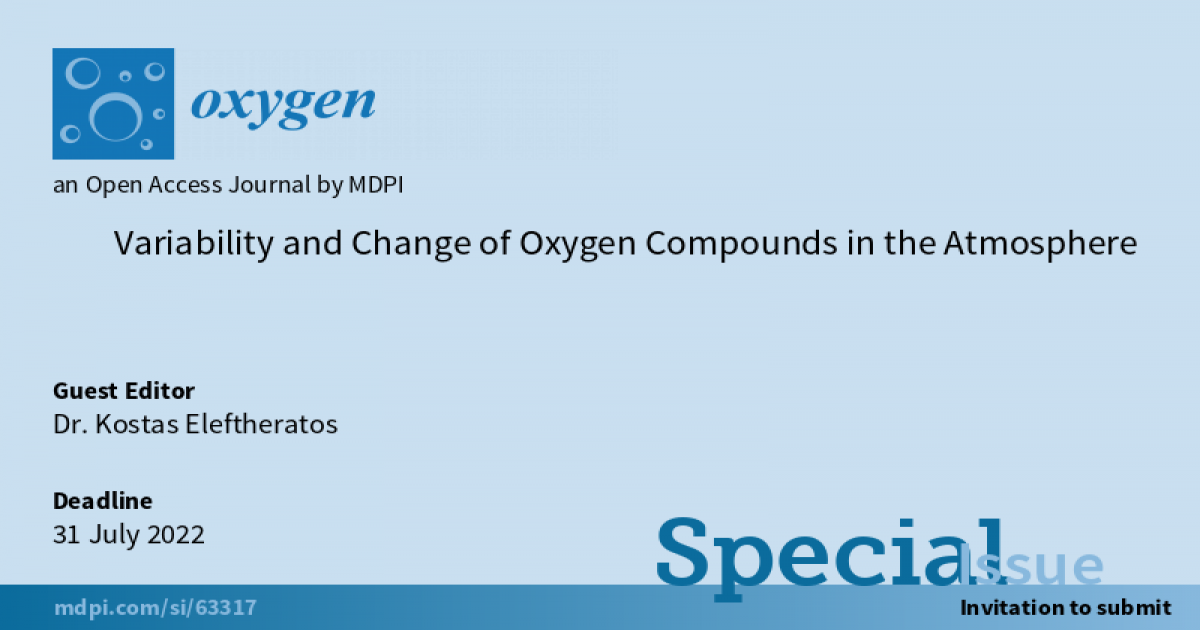- Tracked forImpact Factor
- 8.4CiteScore
- 25 daysTime to First Decision
Variability and Change of Oxygen Compounds in the Atmosphere
Special Issue Information
Dear Colleagues,
Oxygen is the second most abundant gas in the atmosphere, behind nitrogen, and it is vital for life on Earth. Oxygen gas reacts with all chemical elements except the noble gases. The products of these chemical reactions are called oxides. Water, the oxide of hydrogen, is the most familiar oxygen compound. Carbon, nitrogen, and sulfur oxides (COx, NOx, and SOx) are other known oxygen compounds of great importance for atmospheric and climate processes. There are also highly reactive—and consequently short lived—oxygen species in the atmosphere such as hydrogen radical (OH¯) and hydrogen peroxide (H2O2). Oxygen compounds are retrieved from ground-based and satellite measurements and are simulated by numerical models. We invite you to submit high quality research papers addressing the variability and change of oxygen compounds on short and long time and space scales in the Anthropocene.
Dr. Kostas Eleftheratos
Guest Editor
Manuscript Submission Information
Manuscripts should be submitted online at www.mdpi.com by registering and logging in to this website. Once you are registered, click here to go to the submission form. Manuscripts can be submitted until the deadline. All submissions that pass pre-check are peer-reviewed. Accepted papers will be published continuously in the journal (as soon as accepted) and will be listed together on the special issue website. Research articles, review articles as well as short communications are invited. For planned papers, a title and short abstract (about 250 words) can be sent to the Editorial Office for assessment.
Submitted manuscripts should not have been published previously, nor be under consideration for publication elsewhere (except conference proceedings papers). All manuscripts are thoroughly refereed through a single-blind peer-review process. A guide for authors and other relevant information for submission of manuscripts is available on the Instructions for Authors page. Oxygen is an international peer-reviewed open access quarterly journal published by MDPI.
Please visit the Instructions for Authors page before submitting a manuscript. The Article Processing Charge (APC) for publication in this open access journal is 1000 CHF (Swiss Francs). Submitted papers should be well formatted and use good English. Authors may use MDPI's English editing service prior to publication or during author revisions.

Benefits of Publishing in a Special Issue
- Ease of navigation: Grouping papers by topic helps scholars navigate broad scope journals more efficiently.
- Greater discoverability: Special Issues support the reach and impact of scientific research. Articles in Special Issues are more discoverable and cited more frequently.
- Expansion of research network: Special Issues facilitate connections among authors, fostering scientific collaborations.
- External promotion: Articles in Special Issues are often promoted through the journal's social media, increasing their visibility.
- e-Book format: Special Issues with more than 10 articles can be published as dedicated e-books, ensuring wide and rapid dissemination.

